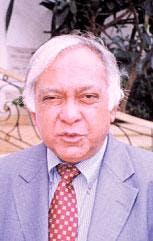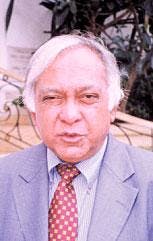The Indian government should offer incentives to companies willing to explore the country’s many untested basins, says Subir Raha, chairman of state-owned Oil & Natural Gas Corp. (ONGC). But a proposal to replace the New Exploration Licensing Policy (NELP) regime with open acreage nomination “is not a solution to attract investors to low-prospectivity blocks.”
India has 26 sedimentary basins but produces hydrocarbons from only six, Raha pointed out in a recent interview with Oil & Gas Journal. Traces of hydrocarbons have been encountered in three or four other basins.
ONGC, for which Raha has worked for 36 years, made the initial discoveries in five of the producing basins. It made its first onshore discovery in 1958 and its first offshore strike in 1974.
Raha said India has oil and gas reserves of about 32 billion tonnes of oil equivalent, only 0.4% of the worldwide total. About 1.1 billion tonnes of proved, recoverable reserves lie offshore. This has been considered too small a target for the big multinational companies.
“No overseas company has shown any interest in carrying exploration risk in any of the basins,” Raha said. “Cairn [Energy PLC] is an exception. They explored in India and did well” (see p. 35).
Lack of interest from major multinationals no longer disappoints ONGC. “Now the company can fund exploration itself” and “does not need the technology or the money,” Raha said.
Partnerships
ONGC works with partners to gain access to farm-in opportunities outside of India, he said. Through ONGC Videsh Ltd. (OVL), the company has 18 exploration and production properties in 13 countries. OVL operates six properties overseas and holds 100% interests in four of them.
Raha cited ONGC partnerships with BP in Vietnam and ExxonMobil in Sakhalin as among the most interesting. OVL made a $1.7 billion investment in Sakhalin several years ago that remains its largest single investment outside of India (OGJ, Mar. 17, 2003, p. 39).
Norsk Hydro presented interesting opportunities in Cuba, he said. In September 2005, ONGC signed a memorandum of understanding (MOU) with Norsk Hydro for a joint venture in Cuba. In November, the companies announced OVL’s agreement with Repsol YPF to acquire 30% participating interest in deepwater exploration Blocks 25, 26, 27, 28, 29, and 36 off northern Cuba. Repsol YPF retains a 40% interest as operator, and Norsk Hydro holds a 30% interest.
Raha said the Cuban oil is a desirable “light, sweet crude.”
In another successful venture, Raha signed an MOU last July on behalf of OVL with Laksmi N. Mittal, chairman and chief executive officer of the Mittal Group, a large steel maker, to form a joint venture called ONGC-Mittal Energy Ltd. (OMEL). OVL will control 51%, the Mittal Investment SARL 49%. Raha told OGJ that Mittal brings networking capabilities and an international reputation, while ONGC will contribute technical skills.
ONGC is also looking at activities in Indonesia, Egypt, Canada, Myanmar, and Nepal while pulling out of other areas. It is leaving northwest Australia after a dry hole; it was unsuccessful in bidding for Buzzard field in the North Sea last year; and it sold its Gulf of Mexico interests in favor of investment opportunities in Sudan.
Focus on training
ONGC maintains an Institute of Drilling Technology (IDT) in Dehradun that Raha described as the “epicenter of drilling solutions.” Founded in 1978 in the valley of Doon, IDT conducts research and development and provides training and consulting.
IDT has an associated well control school that is accredited by the International Well Control Forum, the Alliance for Well Control, and the International Association of Drilling Contractors and that offers the internationally recognized well control accreditation program WellCAP.
Raha is interested in “building indigenous capability.” Most of the oil companies in India have people trained by ONGC, he said.
Latest investments
ONGC is involved in a number of ambitious projects, upstream and downstream.
Last July, the Indian government approved an investment valued at about $4.75 billion in an LNG, power, and petrochemicals project in Mangalore to be implemented by Mangalore Refinery & Petrochemicals Ltd., an ONGC subsidiary.
ONGC will assume 30% of the costs of developing Cairn Energy’s Mangala oil discovery in Rajasthan. “We’ll be paying a lot,” Raha said, but “we’re keen to bring production online.” He mentioned the possibility of setting up a refinery in Rajasthan as an ONGC project to add as much value to the production as possible. The downstream aspects would include, first, a pipeline to a Gujarat port and perhaps a central tank farm later.
Raha thought a refinery could be built in 3 years. He said the company was prepared to tackle the refinery project on its own but was “open to have Cairn join us.”
OVL recently finished building a products pipeline in Sudan and is involved in discussions with two other countries, Raha said. OVL wants exploration opportunities, and other countries want refineries and pipelines.
ONGC has the highest market capitalization in India-$30 billion-followed by Reliance Industries, at $26 billion. OVL has the highest net worth, at $10 billion, and is ranked 454 globally on the Fortune 500 list. “Given all that,” Raha said, “raising funds is not a problem.”
Raha would not discuss the long-term oil price scenario the company uses in modeling, but he noted that ONGC is conservative. “We lost some bids to China,” he said. “We assume that the technical analysis must have been the same, so the bid either reflected a lower cost of capital or a lower rate of return.”
Coal, privatization
Raha discussed a move into coal through both coalbed methane development and coal gasification projects. He said India has a large resource base, but the coal is of relatively poor quality with high ash content.
In November, Raha said ONGC planned to launch coal gasification pilots by the end of the year.
Raha said privatization of ONGC, meaning a drop in government ownership below 50%, will not happen. The government will not relinquish control of certain Indian industries.
This is not for lack of interest by the market. When 10% of ONGC was offered publicly in March 2002, Raha said, the offer was sold in 15 min and was five times oversubscribed.
Currently, the Indian government controls 74% of ONGC. A further 12% is controlled by international oil companies and by the Gas Authority of India Ltd. The remaining 14% is on the market, including the 10% stake offered in 2002. ONGC has the ability to float OVL at any time, Raha said. But he added that spinning off the international unit “shall not happen.” ✦
Career highlights
Subir Raha was named chairman and managing director of Oil & Natural Gas Corp., India’s largest state-owned company, in May 2001. He is also chairman of ONGC Videsh Ltd. and Mangalore Refinery & Petrochemicals Ltd.
Employment
Raha joined state-owned refiner-marketer Indian Oil Corp. in 1970 as a management trainee. Following several field and staff assignments, he served India’s government as head of the Oil Coordination Committee in the Ministry of Petroleum and Natural Gas. He later joined the IOC board as director, human resources. Concurrently, he had responsibilities for IOC business development, information technology, and corporate communications. Raha also created and chaired several of IOC’s joint ventures with other firms.
Education
Raha was graduated in 1969 from Jadavpur University with electronics and telecommunications engineering as his electives and received an MBA from the University of Leeds in 1985. He also is an alumnus of the Administrative Staff College at Henley, UK.

